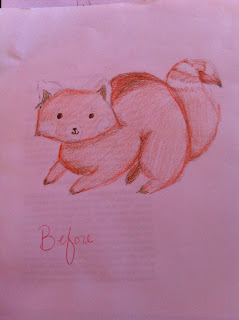 |
| Pre-Evolution: 50% of the Parrots are blue, 50% of the Parrots are green. |
 |
| Fire! Half of the Parrot population is killed. |
 |
| Post-Evolution: 80% of the Parrots are blue, 20% of the Parrots are green. |
My model shows the effects of genetic drift on a population of parrots in a rainforest. I chose to model genetic drift by creating a "snapshot" of the area that a population of parrots is living in. I then created two more "snapshots" of the area: one showing a fire raging through the rainforest, the source of genetic drift, and another one showing the the area after the fire had occurred. I choose to model the evolutionary process this way because one can clearly see the differences in the Parrot population before and after the fire. The Pre-Evolution model depicts a population of parrots. 50% of the parrots have blue feathers, while the other 50% have green feathers. Neither the blue nor the green parrots have any special advantage over the other. Also, all of the parrots in the population are randomly distributed throughout their habitat. The "Fire" model depicts a massive fire burning down part of the parrots' habitat. Since genetic drift is a random mode of evolution, the fire randomly kills both blue and green parrots. The Post-Evolution model depicts the aftermath of the fire and genetic drift. Due to the random killing off of parrots, the population is no longer 50% blue, 50% green. Instead, since more green parrots were killed than blue ones, the population is now 80% blue, 20% green. The source of the variation that lead to the evolution in the parrots was the different color feathers the parrots had. The parrots could have either blue feathers or green feathers, and no color had an advantage over the other color.






